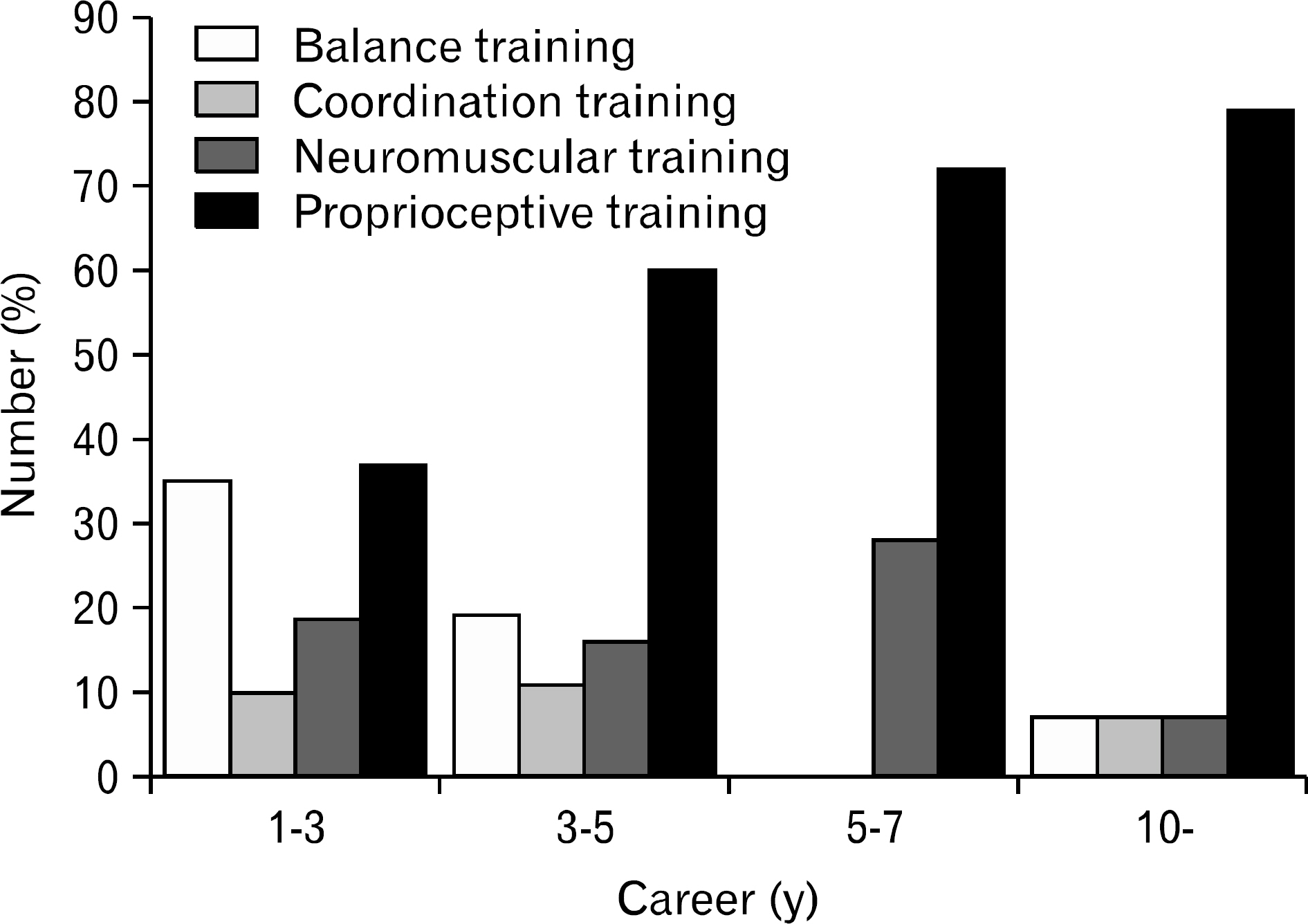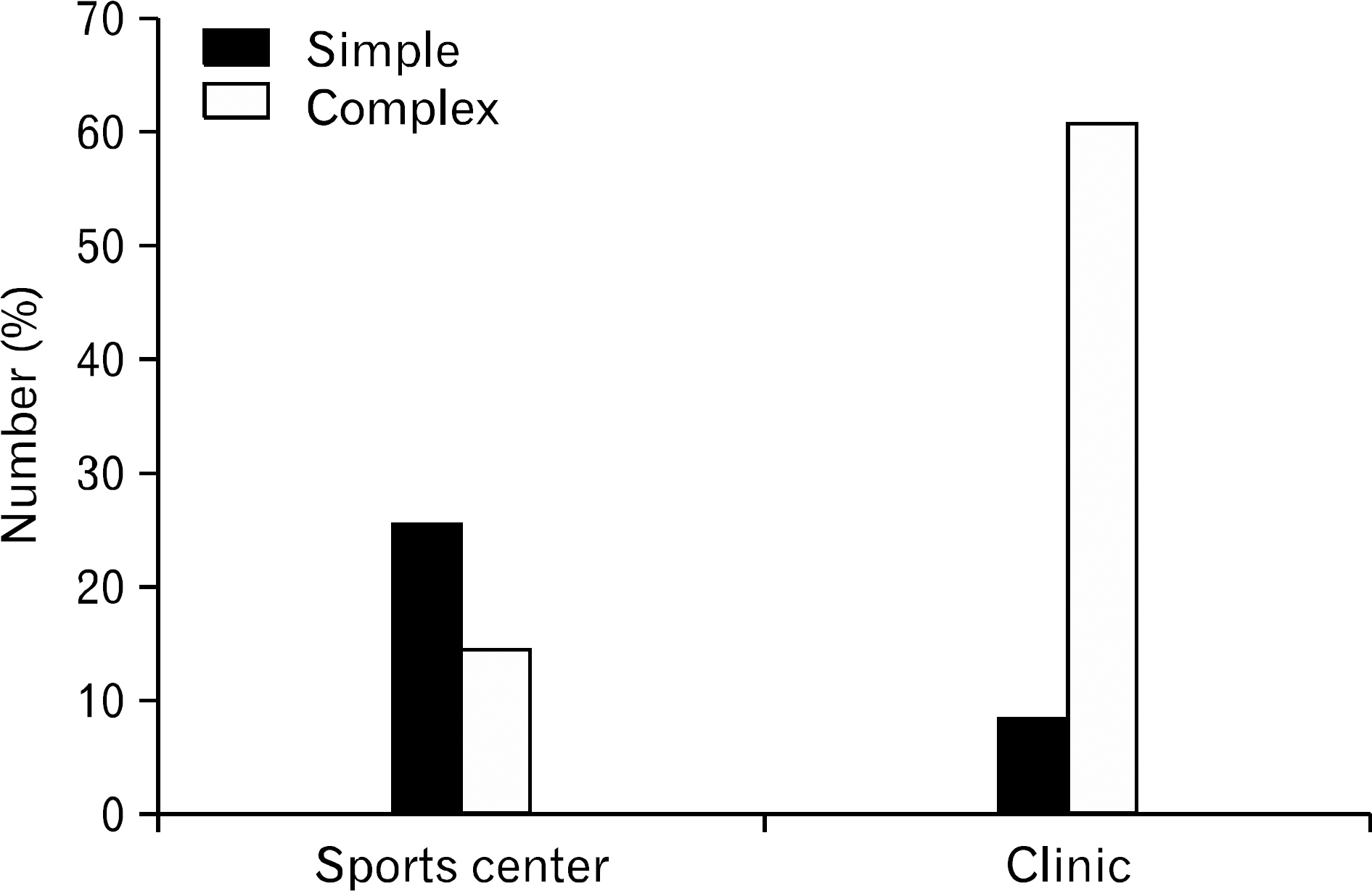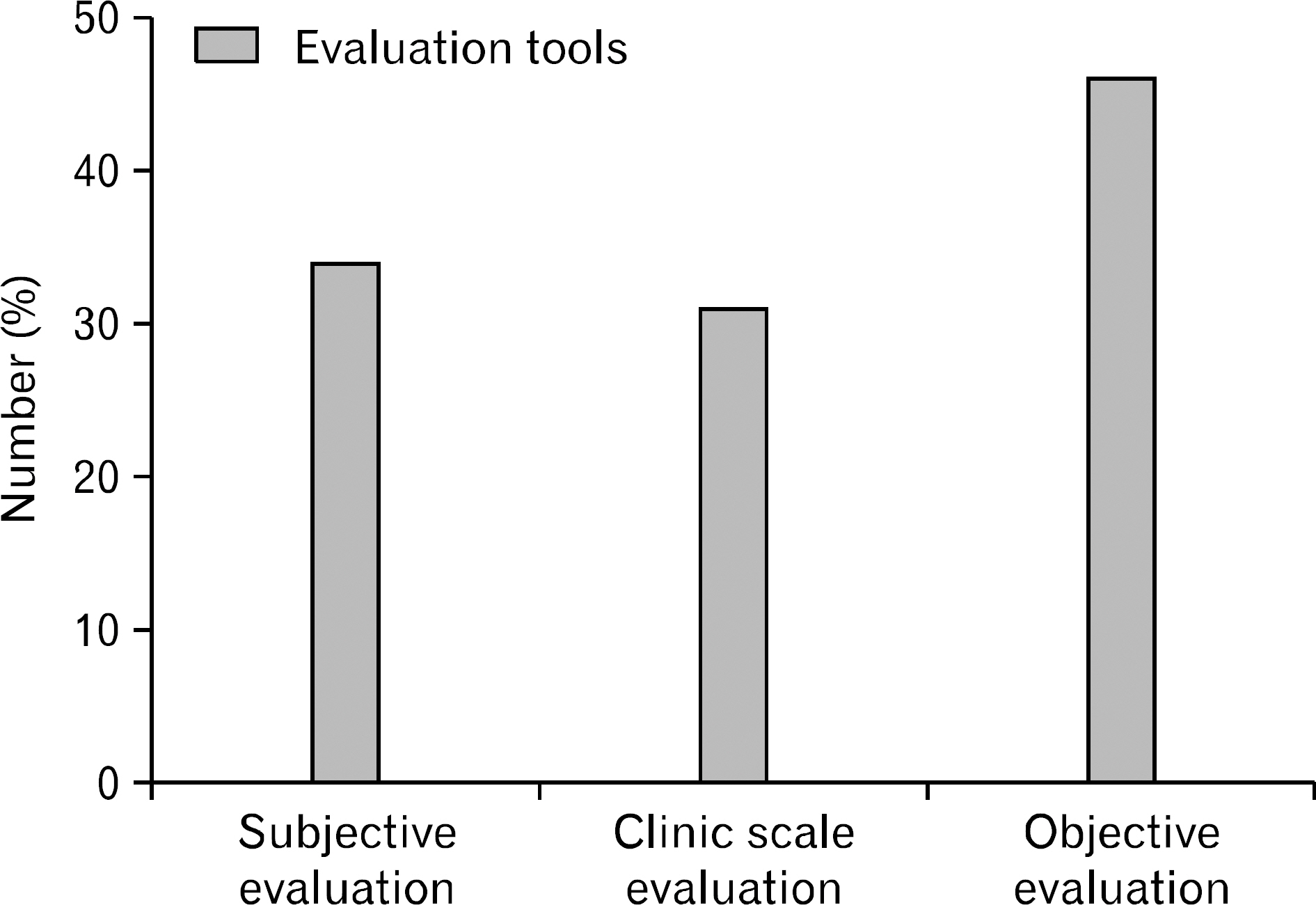Korean J Sports Med.
2012 Jun;30(1):23-33. 10.5763/kjsm.2012.30.1.23.
Perception of Balance Training and Evaluation
- Affiliations
-
- 1Samsung Biomedical Research Institute, Samsung Medical Center, Seoul, Korea.
- 2Department of Physical and Rehabilitation Medicine, Samsung Medical Center, Sungkyunkwan University School of Medicine, Seoul, Korea. jhlee.hwang@samsung.com
- 3Department of Rehabilitation Medicine, Pusan National University Yangsan Hospital, Yangsan, Korea.
- 4Division of Biomedical Engineering, Chonbuk National University, Jeonju, Korea.
- KMID: 2288645
- DOI: http://doi.org/10.5763/kjsm.2012.30.1.23
Abstract
- The purpose of this study was to survey the athletic trainers' recognition, need and evaluation for balance training and to investigate training and evaluation methods in the actual implementation. One hundred fifty trainers were participated in the survey. The study questionnaire of 24 encompassed five separated issues; basic characteristics of trainers, awareness and the need for balance, balance assessment and training content, assessment and training equipment, and education and need. Balance training were recognized as simple balance training in 20.7% of trainers, and as proprioception in 64.9%. Trainers with high needs of balance training were 69.4%. The percentage of trainers with protocol of balance training were 73.9%, and the trainers with complex equipments including software and hardware were 66.7%. Trainers with needs of education for training protocol, theoretical education for balance, and training equipment were 79.3%, 56.8%, and 63.1%. The results showed that educations for concept of balance training and sports injury rehabilitation, and research opportunities had to be provided to athlete trainers. We think that the results of this study can help athlete trainers to apply high-quality sports rehabilitation for athletes.
Keyword
Figure
Cited by 1 articles
-
The Changes of Contraction Patterns in Trunk Muscles with Multidirectional Tilting Motion on the Dynamic Posturography
Songjun Kim, Meehee Won, Sunghoon Hur, Kyungjun An, Jongsam Lee
Korean J Sports Med. 2019;37(3):84-93. doi: 10.5763/kjsm.2019.37.3.84.
Reference
-
References
1. Stelmach GE, Teasdale N, Di Fabio RP, Phillips J. Age related decline in postural control mechanisms. Int J Aging Hum Dev. 1989; 29:205–23.
Article2. Bahr R, Lian O, Bahr IA. A twofold reduction in the incidence of acute ankle sprains in volleyball after the introduction of an injury prevention program: a prospective cohort study. Scand J Med Sci Sports. 1997; 7:172–7.
Article3. Caraffa A, Cerulli G, Projetti M, Aisa G, Rizzo A. Prevention of anterior cruciate ligament injuries in soccer. A prospective controlled study of proprioceptive training. Knee Surg Sports Traumatol Arthrosc. 1996; 4:19–21.4. Hewett TE, Lindenfeld TN, Riccobene JV, Noyes FR. The effect of neuromuscular training on the incidence of knee injury in female athletes. A prospective study. Am J Sports Med. 1999; 27:699–706.5. Holme E, Magnusson SP, Becher K, Bieler T, Aagaard P, Kjaer M. The effect of supervised rehabilitation on strength, postural sway, position sense and re-injury risk after acute ankle ligament sprain. Scand J Med Sci Sports. 1999; 9:104–9.
Article6. Myklebust G, Engebretsen L, Braekken IH, Skjolberg A, Olsen OE, Bahr R. Prevention of anterior cruciate ligament injuries in female team handball players: a prospective intervention study over three seasons. Clin J Sport Med. 2003; 13:71–8.
Article7. Wedderkopp N, Kaltoft M, Lundgaard B, Rosendahl M, Froberg K. Prevention of injuries in young female players in European team handball. A prospective intervention study. Scand J Med Sci Sports. 1999; 9:41–7.
Article8. Davlin CD. Dynamic balance in high level athletes. Percept Mot Skills. 2004; 98:1171–6.
Article9. Willson JD, Dougherty CP, Ireland ML, Davis IM. Core stability and its relationship to lower extremity function and injury. J Am Acad Orthop Surg. 2005; 13:316–25.
Article10. Conn JM, Annest JL, Gilchrist J. Sports and recreation related injury episodes in the US population, 1997–99. Inj Prev. 2003; 9:117–23.
Article11. Hawkins RD, Fuller CW. A prospective epidemiological study of injuries in four English professional football clubs. Br J Sports Med. 1999; 33:196–203.
Article12. Powell JW, Barber-Foss KD. Injury patterns in selected high school sports: a review of the 1995–1997 seasons. J Athl Train. 1999; 34:277–84.13. Cho HJ, Cho DS, Park SB, Yun SR, Jung KI. The effect of knee osteoarthritis and unilateral total knee arthroplasty on balance. J Korean Acad Rehabil Med. 2007; 31:725–29.14. Jang ES, Yang WH, Kim KY. The effects of balance training using balance system in the hemiplegic patients. J Korean Acad Rehabil Med. 1999; 23:899–904.15. Lindsay DM, Horton JF, Vandervoort AA. A review of injury characteristics, aging factors and prevention programmes for the older golfer. Sports Med. 2000; 30:89–103.
Article16. Lim KB, Lee HJ, Joo SJ, et al. Postural control measures of golfers using balance master system. Korean J Sports Med. 2008; 24:152–7.17. Hamilton WG, Hamilton LH, Marshall P, Molnar M. A profile of the musculoskeletal characteristics of elite professional ballet dancers. Am J Sports Med. 1992; 20:267–73.
Article18. Tropp H, Askling C, Gillquist J. Prevention of ankle sprains. Am J Sports Med. 1985; 13:259–62.
Article19. Wester JU, Jespersen SM, Nielsen KD, Neumann L. Wobble board training after partial sprains of the lateral ligaments of the ankle: a prospective randomized study. J Orthop Sports Phys Ther. 1996; 23:332–6.
Article20. van der Wees PJ, Lenssen AF, Hendriks EJ, Stomp DJ, Dekker J, de Bie RA. Effectiveness of exercise therapy and manual mobilisation in ankle sprain and functional instability: a systematic review. Aust J Physiother. 2006; 52:27–37.21. Hubscher M, Zech A, Pfeifer K, Hansel F, Vogt L, Banzer W. Neuromuscular training for sports injury prevention: a systematic review. Med Sci Sports Exerc. 2010; 42:413–21.22. Engebretsen AH, Myklebust G, Holme I, Engebretsen L, Bahr R. Prevention of injuries among male soccer players: a prospective, randomized intervention study targeting players with previous injuries or reduced function. Am J Sports Med. 2008; 36:1052–60.23. Soderman K, Werner S, Pietila T, Engstrom B, Alfredson H. Balance board training: prevention of traumatic injuries of the lower extremities in female soccer players? A prospective randomized intervention study. Knee Surg Sports Traumatol Arthrosc. 2000; 8:356–63.24. Shelbourne KD, Klootwyk TE, Wilckens JH, De Carlo MS. Ligament stability two to six years after anterior cruciate ligament reconstruction with autogenous patellar tendon graft and participation in accelerated rehabilitation program. Am J Sports Med. 1995; 23:575–9.
Article25. Hewett TE, Stroupe AL, Nance TA, Noyes FR. Plyometric training in female athletes. Decreased impact forces and increased hamstring torques. Am J Sports Med. 1996; 24:765–73.26. Verhagen E, van der Beek A, Twisk J, Bouter L, Bahr R, van Mechelen W. The effect of a proprioceptive balance board training program for the prevention of ankle sprains: a prospective controlled trial. Am J Sports Med. 2004; 32:1385–93.27. Emery CA, Cassidy JD, Klassen TP, Rosychuk RJ, Rowe BH. Effectiveness of a home-based balance-training program in reducing sports-related injuries among healthy adolescents: a cluster randomized controlled trial. CMAJ. 2005; 172:749–54.
Article
- Full Text Links
- Actions
-
Cited
- CITED
-
- Close
- Share
- Similar articles
-
- The Effects of Balance Training Using Balance System in the Hemiplegic Patients
- The Effects of Biofeedback Balance Training Using InteractiveBalance System in Acute Stroke Patients
- Effect of Action Observation Training Using Y-Balance on Balance Capability in Young Adults
- Visual Biofeedback Balance Training Using COBETS
- Effect of Balance Board Training with Tactile Stimulation on Affected Leg in Hemiplegic Patient




